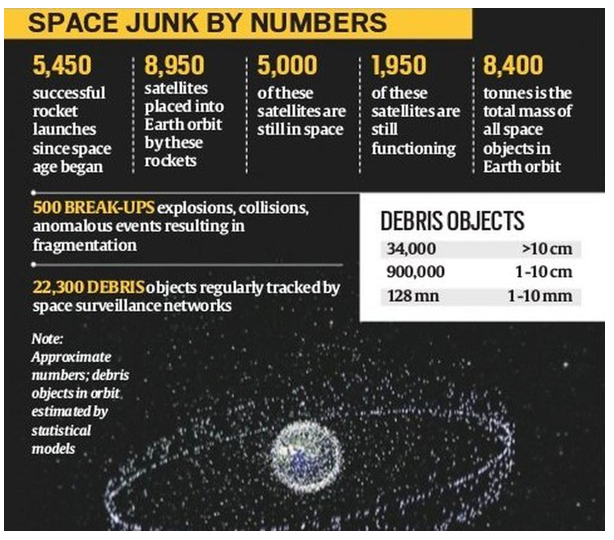- Courses
- GS Full Course 1 Year
- GS Full Course 2 Year
- GS Full Course 3 Year
- GS Full Course Till Selection
- MEP (Mains Enrichment Programme) Data, Facts
- Essay Target – 150+ Marks
- Online Program
- GS Recorded Course
- NCERT- First Ladder
- Polity
- Geography
- Economy
- Ancient, Medieval and Art & Culture AMAC
- Modern India, Post Independence & World History
- Environment
- Governance
- Science & Technology
- International Relations and Internal Security
- Disaster Management
- Ethics
- Current Affairs
- Indian Society and Social Issue
- CSAT
- 5 LAYERED ARJUNA Mentorship
- Public Administration Optional
- ABOUT US
- OUR TOPPERS
- TEST SERIES
- FREE STUDY MATERIAL
- VIDEOS
- CONTACT US
ISROs rocket parts found on Australian shore
ISROs rocket parts found on Australian shore
08-08-2023

Latest Context:
Recently, some parts of ISRO’s rocket were found on the Australian shore.
What are space debris?
- Space debris, also known as orbital debris or space junk, refers to non-functional, human-made objects that are orbiting the Earth.
- These objects range in size from tiny paint flecks to defunct satellites and spent rocket stages. They are the result of decades of space exploration, satellite launches, and various space activities.
Space debris can be categorized into several groups:
- Fragmented Debris: These are the result of collisions or explosions in space. When two large objects collide, they can break into numerous smaller pieces. For example, the 2007 Chinese anti-satellite test created a significant amount of fragmented debris.
- Defunct Satellites: Satellites that have reached the end of their operational life become debris themselves, once they are no longer under control. These defunct satellites can remain in orbit for years, posing a potential collision risk.
- Rocket Bodies: The discarded upper stages of launch vehicles used to place satellites into orbit are another source of space debris. Once their primary mission is complete, these stages remain in orbit as additional debris.
- Small Debris: Even small particles, such as paint flecks and screws, can become space debris if they are traveling at high speeds. These particles can cause damage due to their kinetic energy when they collide with operational satellites.

Impact of space debris can be:
- Collision Risk: One of the most immediate impacts of space debris is the increased risk of collisions. As the amount of debris in orbit continues to grow, the likelihood of collisions increases. These collisions can cause damage to or even destruction of valuable assets in space.
- Satellite Damage: Space debris can damage or disable operational satellites, disrupting communication, navigation, weather forecasting, earth observation, and other essential services that rely on satellite technology.
- Space Station Safety: The International Space Station (ISS) and other crewed spacecraft are particularly vulnerable to space debris due to their larger cross-sectional areas. Even small pieces of debris can pose a significant threat to the safety of astronauts on board.
- Increased Launch Costs: To mitigate the risk of space debris collisions, satellites and space missions may need to be designed with additional shielding or propulsion systems for collision avoidance. This can increase the complexity and cost of space missions.
- Limitations on Future Space Activities: As the amount of space debris increases, certain orbital regions may become too hazardous for new satellite launches or other space activities. This can limit our ability to utilize certain orbits and conduct future space missions.
- Fear of Kessler Syndrome: If a significant collision occurs and it generated a large amount of additional debris, then it can trigger a chain reaction known as the Kessler syndrome. This will involve a series of collisions creating more debris, making certain orbital regions virtually unusable for a long time.
- Sustainability of Space Exploration: As space debris accumulates, the long-term sustainability of space exploration is at risk. Without effective debris mitigation and removal strategies, the space environment could become increasingly polluted and hazardous.
- Environmental Impact: In the event of a collision, debris could re-enter the Earth's atmosphere and potentially pose a risk to people and property on the ground.
- Data Collection Challenges: Monitoring and tracking space debris is a complex task, especially for smaller debris fragments. The accuracy of tracking data is crucial for collision avoidance and inaccurate data can lead to misjudgements and potential collision.
Regulations governing space debris are:
- Outer Space Treaty (1967): The Outer Space Treaty, adopted by the United Nations, serves as the foundation for international space law. While it doesn't specifically address space debris, it emphasizes the peaceful use of outer space and the prevention of harmful contamination of celestial bodies, including Earth's orbit. It forms the basis for many subsequent agreements.
- Convention on International Liability for Damage Caused by Space Objects 1972 (Liability Convention): It deals with damage caused by space objects to other space assets, and by falling objects on earth. Convention provides for procedures for settlement of claims for damages. As of 1st January 2023, 98 States (including India) have ratified it.
- Guidelines for the Long-Term Sustainability of Outer Space Activities (2019): Adopted by the United Nations Committee on the Peaceful Uses of Outer Space (COPUOS), these guidelines provide recommendations for spacefaring nations to ensure the long-term sustainability of outer space activities. They cover various aspects, including debris mitigation, end-of-life disposal, and cooperation in space situational awareness.
- Space Debris Mitigation Guidelines: Also established by COPUOS, these guidelines provide recommendations for minimizing the creation of new space debris during the design, launch, and operation of space missions. They include measures such as limiting debris generation during spacecraft separation, depleting onboard propellants, and avoiding long-term presence in certain orbital regions.
- Inter-Agency Space Debris Coordination Committee (IADC): The IADC is an international forum that promotes coordination among space agencies and organizations for space debris mitigation. It shares information, conducts research, and develops best practices for debris avoidance and mitigation.
- United Nations Office for Outer Space Affairs (UNOOSA): UNOOSA is responsible for promoting international cooperation in the peaceful use and exploration of outer space. It supports the development and implementation of space debris mitigation measures and facilitates discussions among member states.
- International Telecommunication Union (ITU): The ITU allocates and coordinates the use of radio frequency spectrum and satellite orbits to prevent interference among satellite systems. It also plays a role in addressing potential debris-related issues related to satellite communication.
Must Check: IAS Coaching Centre In Delhi



